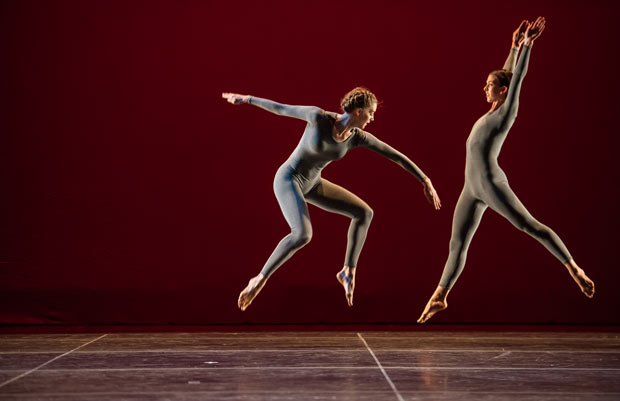
© Stephanie Berger. (Click image for larger version)
Trisha Brown Dance Company
Proscenium Works, 1979–2011: Set and Reset, Present Tense, Newark (Niweweorce)
★★★★✰
New York, Brooklyn Academy of Music
28 January 2015
www.trishabrowncompany.org
www.bam.org
Clever Games
“Trisha Brown’s dances are shaped by dreams of levitation, by geometry, enigma, physics, by memory, mathematics, and geography,” writes Marianne Goldberg in her volume Fifty Contemporary Choreographers. Which is funny, because the word that pops into my mind most readily as I watch Brown’s dances is “play.” Her dancers – cool, smart, liquid-moving – look like superior beings engaged in very clever and engrossing (though not over-exciting) games, for which only they know the rules. Tonight, at the Brooklyn Academy of Music, they presented three of these playful dances, perhaps for the last time.
Brown is the latest in a line of moderns and post-moderns whose companies are embarking on a future without the guidance of their founder and creative spirit. Brown is still with us, thankfully, but has retired from dancemaking due to ill health. So what is the company to do? Her hand-picked successors, Diane Madden and Carolyn Lucas, have come up with a plan of sorts (with details still to be fully worked out). First, a world tour, which is now wrapping up, of Brown’s major pieces for the stage, entitled “Proscenium Works, 1979–2011.” (After New York, it goes to Portland, and then that’s it.) Then, a shift in operations from large-scale performances to site-specific presentations of material from Brown’s fifty-year-long repertory (outdoors, in galleries, etc).
This approach – called “Trisha Brown: In Plain Site” – will suit the early works, especially: experiments in movement, space and gravity-defiance, that were never meant to be seen in a theatre in the first place. In these pieces, dancers walked on walls, picked up sticks, rappelled down the sides of buildings, or sent messages to each other from one building to the next.
What will happen with the more elaborate works, collaborations with artists like Donald Judd and Robert Rauschenberg, is more of an open question. The hope is that other companies will perform them, under the guidance of Madden and Lucas. But tonight, New Yorkers got a last glimpse of three of them as performed by Brown’s own company. In some ways, the transition has already begun – most of the dancers at BAM were new recruits, not veterans.
Two of the dances – Set and Reset and Newark (Niweweorce) – were made in the eighties, and one, Present Tense, in 2003. The program was well chosen; the pieces were highly distinctive in look, sound, and mood. Brown’s technique is very particular; more than almost any other choreographer, she makes you aware that the human body is a structure made out of many moving parts, connected by joints. Everything moves and swings and twists and bends, freely and loosely. There is very little force involved, and almost no tension; most of the movement seems to spring directly from the laws of physics: gravity, momentum, torque, rebound.
Brown can make the most knotty problems – how to get this person up and over and twisted and flipped and turned around and back down again – look amazingly easy. That’s where the cleverness comes in; every problem has a solution, and the solution is intrinsically interesting. But, especially in the long pieces, this equanimity can become tiring. They could end at any time, or go on forever.

© Stephanie Berger. (Click image for larger version)
Fatigue did set in for me toward the middle of the last piece, Newark (Niweweorce), with its sliding colored walls and buzzing “sound concept” by Donald Judd. It was the most obviously formal of the three pieces, centered on a doubling theme: two men (Olsi Gjeci and Stuart Shugg), cycled through extended, coordinated phrases of tilts, bends, crouches, pivots, and falls, while three women entered and exited from the wings, loping and gliding, spinning and running. Walls came down and rose up again. New configurations came and went. Later, an acrobatic element crept in, with dancers lifting and bending each other in ingenious ways. But for all its stylishness and formal elegance there is a solemnity to Newark that I find deflating.

© Stephanie Berger. (Click image for larger version)
Not so the other two works. Set and Reset, which opened the program, is buoyed by an endless playfulness, sustained by the pulse of Laurie Anderson’s clanging, bubbling electronic score, Long Time No See. The piece is also impossibly cool: dispassionate, relaxed, self-aware. You feel cooler just by watching it. (The geometric, silvery light sculpture and loose costumes are by Robert Rauschenberg.) The choreography is full of ripples and collisions, leg swings, and easy-peasy jumps from the wings. The dancers – especially tall, lanky Marc Crousillat – move with a seductive freedom, forming patterns that hold still just an instant before dispersing into space like stardust. Occasionally, a couple walks, without fuss or reason, across the back of the stage, behind a scrim. The dance begins on the right side of the stage and ends on the left; the space in between is a playground. (Brown does not really go in for endings. The pieces could simply go on forever.)
Present Tense, so rarely performed that it had to be reconstructed from notes and video, is all about formations, mutating human sculptures built out of multiple bodies. The dancers balance against each other, climb, dive, lift and flip each other into the air. Here we see the sheer fecundity of Brown’s imagination, her ability to create mechanical riddles and solve them in constantly surprising ways, without repeating herself. The cheerful, brightly colored designs, by Elizabeth Murray, add to this dance’s gentle, joyful atmosphere, as does the rhythmic, almost child-like score for prepared piano by John Cage (Sonatas and Interludes).
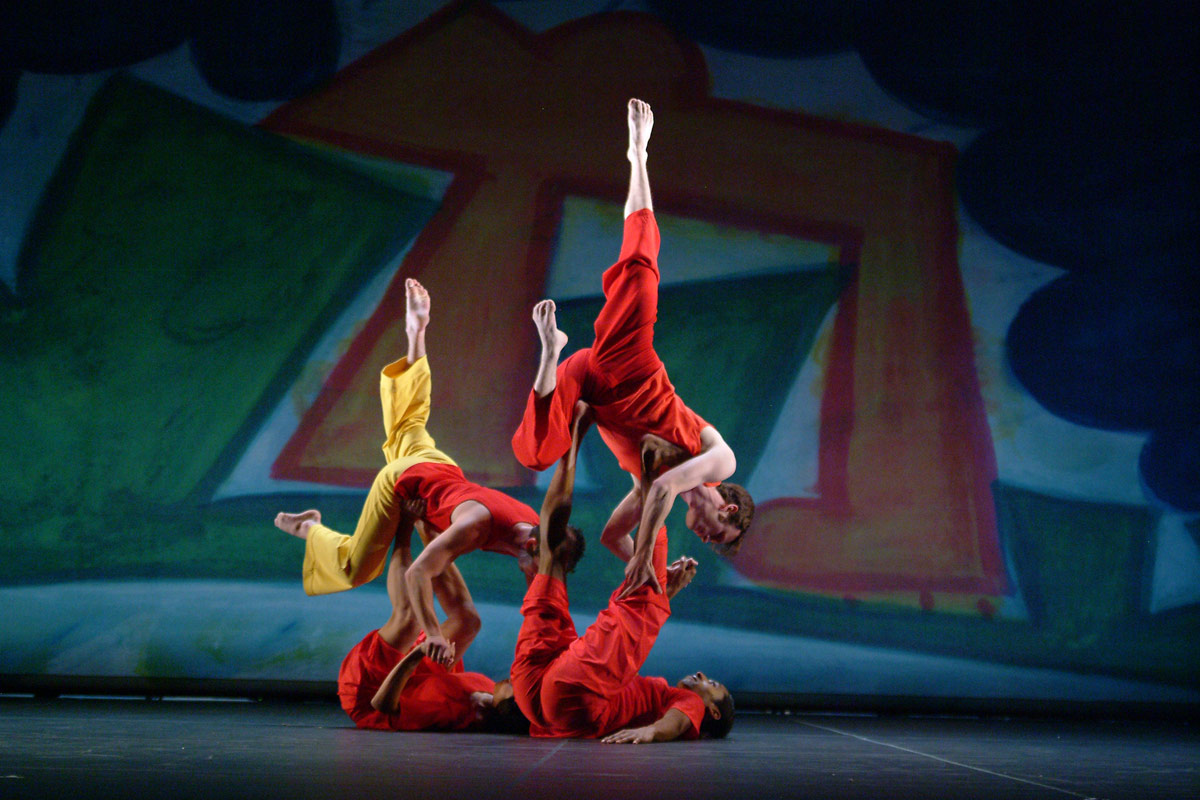
© Nan Melville. (Click image for larger version)
One of the things I admire most about these works is the degree to which men and women are interchangeable. Brown’s movement has no maleness or femaleness attached to it. The dancers are idealizations, super-limber and capable versions of ourselves. Brown’s works suggest that anything is possible. They are a utopia of movement.
Whether they will survive in their current form, however, is a separate question. Only time will tell.












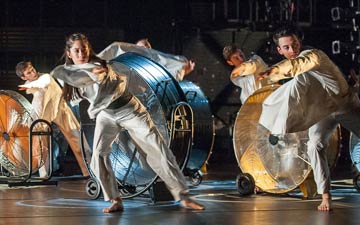
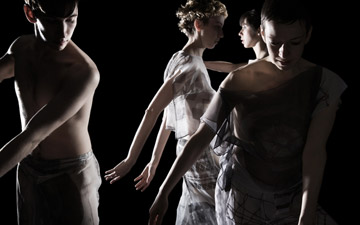
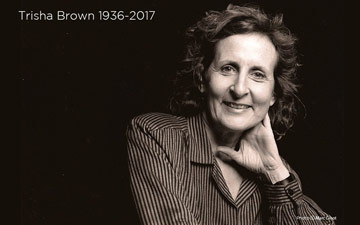

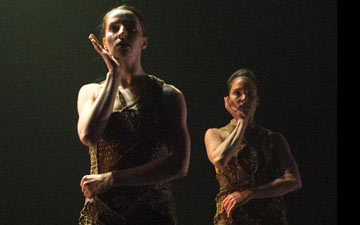
You must be logged in to post a comment.